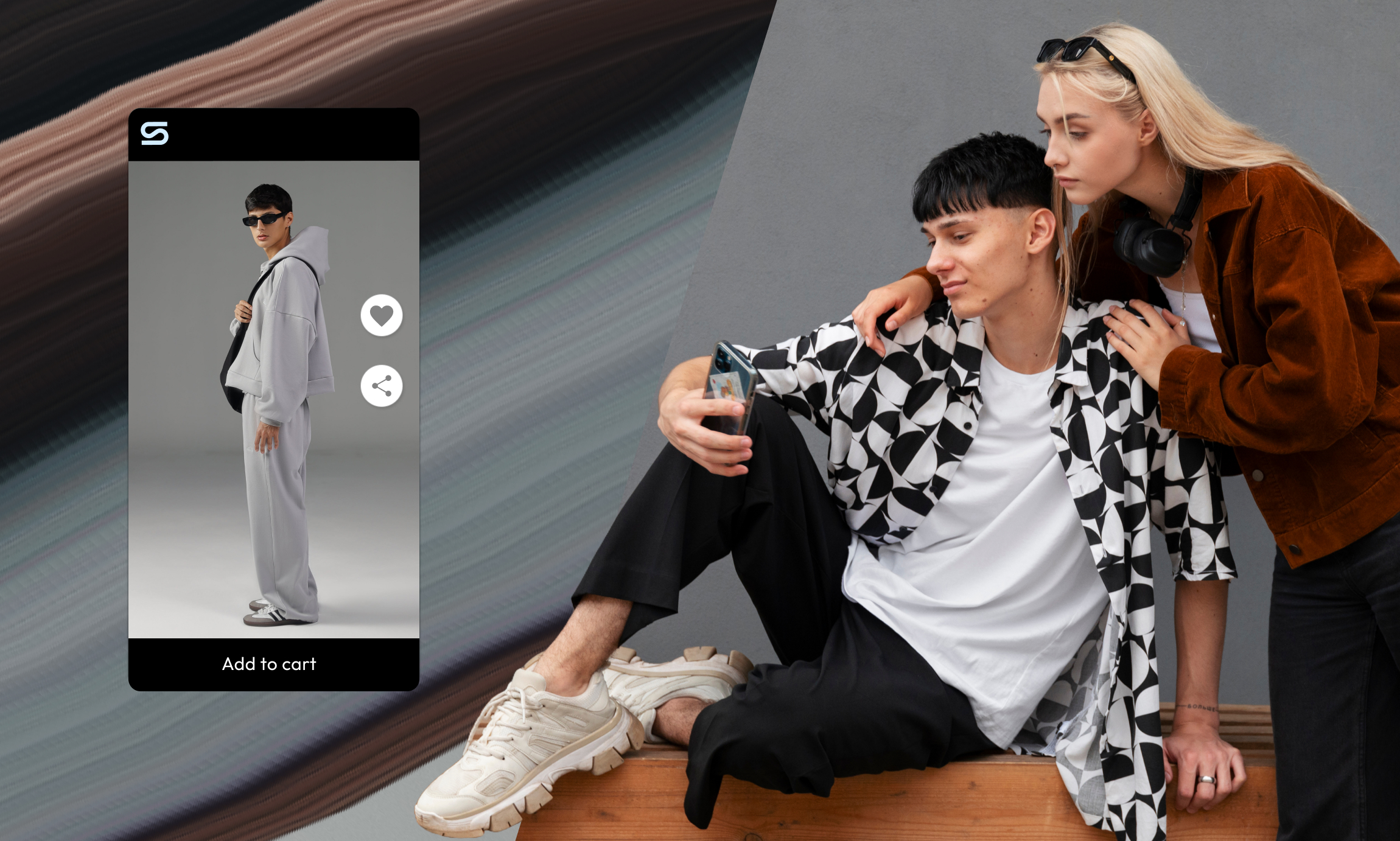September 2024
Social Selling in Fashion E-Commerce
Ester Bazzanella

Social selling is an approach to sales that focuses on building relationships with your shoppers.
Why is this an effective strategy?
Because when it comes to shopping online, people have come to expect increasingly personalized experiences. On top of that, shoppers are spending more and more time on social media.
Social selling helps your brand capitalize on both. It takes advantage of social media and lets your brand engage shoppers more effectively.
In this post, you’ll learn exactly what social selling is, its benefits, and best practices to incorporate social selling into your marketing strategy.
What is Social Selling?
As we’ve mentioned, social selling is all about nurturing relationships with potential customers as part of the sales process.
These relationships can be online or offline but are increasingly taking place on social media platforms.
As a fashion brand, social media platforms are critical for social selling for a few reasons:
- Large user bases: The massive amount of users on social media means you can directly engage large audiences throughout their purchasing journey.
- Highly visual: Platforms like TikTok, Instagram, and Pinterest are highly visual platforms making them ideal for you to showcase your clothing while connecting with users.
- Two-way communication: Social media platforms allow for two-way, real-time communication between your brand and your shoppers. This helps build loyalty and trust as customers feel seen and heard.
- Community building: On social media, you can create communities in which users connect with each other and share experiences about your brand. This amplifies the reach and impact of social selling.
- Data and analytics: With rich data and analytics, social media platforms give you crucial insights about customer preferences. In addition, metrics allow you to track and measure the effectiveness of your social selling efforts and continuously optimize your strategies.
- Shoppable posts: Since you can sell directly through social media platforms, they’re ideal to take advantage of the relationships you nurture on them.
Unlike traditional social media marketing, which focuses on broadcasting messages to a wide audience, social selling is a more personalized approach. It involves actively listening to and interacting with individual users.
Why is social selling important?
Customers know when they’re being sold to, and they don’t like it.
Imagine a shopper looking to purchase a pair of running shoes. They enter a store and are immediately approached by a salesperson who asks if they want to try on a pair of shoes or are looking for anything in particular.
The customer can sense that the salesperson is trying to sell to them. This puts them on the defensive and they might even end up being a little standoffish.
But what if the salesperson took a different approach?
What if they took a genuine interest in the customer and asked them questions about their running?
In this scenario, the customer feels like the salesperson isn’t just trying to sell to them but instead trying to better understand their habits and preferences to give them a personalized recommendation.
That’s why social selling is important.
It helps you truly connect with your shoppers. With social selling, customers feel like you care about them, and this makes them much more likely to make a purchase.
By fostering genuine connections and providing tailored recommendations, you can establish trust and credibility with your audience. You can drive conversions for your brand in a way that feels organic and customer-centric.
Benefits of Social Selling in Fashion E-Commerce
Increased brand awareness: Social selling boosts your brand’s visibility by connecting with customers where they already spend their time online.
Higher conversion rates: Addressing customer concerns in real-time, providing personalized recommendations, and highlighting social proof, can significantly influence purchasing decisions.
Data-driven insights: Social selling gives you valuable insights into what your customers love, helping you fine-tune your marketing and product strategies.
Cost-effective marketing: Social selling can be a much more cost-effective marketing strategy compared to traditional advertising. By leveraging existing social media platforms and organic interactions, you can reach a large audience without significant advertising spend.
Best Practices for Social Selling in Fashion E-Commerce
Okay, now that you have a better understanding of social selling, let’s look at some best practices:
Be a Social Media User
Engaging with your audience on social media goes without saying. It’s the social aspect of social selling. By interacting with users on social media, you can build meaningful relationships.
Engagement takes different forms: responding to comments and reviews, hosting livestreams, sharing style tips – in short, anything that opens a dialogue between you and your shoppers.
Being consistent with your customers lets them know you’re listening. Moreover, interacting with your customers lets you better understand their preferences and needs. And the more you can tailor your messaging, offerings, and products to your audience, the better off your brand will be.
Build an Authentic Brand Presence
Branding is very important in fashion. Read that back because the importance cannot be understated.
Branding in fashion usually draws thoughts of logos, designs, and price points. As it relates to social selling, however, it has more to do with how your brand communicates with your audience.
Your brand’s voice and tone aren’t what’s important here. Different brands communicate in different ways. What’s important in social selling is being consistent.
No matter where potential shoppers are interacting with your brand, they should always feel like they’re communicating with the same brand.
Leverage User-Generated Content (UGC)
User-generated content is an essential component of social selling. Many social media users naturally tag brands when they post photos and videos wearing their clothes. Encourage your customers to do the same and engage with their content when they do.
Sharing UGC contributes to a number of the most beneficial aspects of social selling:
- UCG is powerful social proof: Showcasing real people wearing your products can influence potential shoppers’ purchasing decisions. It shows them that your clothing has been approved and is being worn by other people just like them.
- Sharing UCG makes users feel seen: When you repost or share UGC, it shows social media users that you see them online. And of course making people seen and heard by your brand is largely what makes social selling so powerful. It significantly strengthens your relationship with your customers and helps convert them into brand ambassadors.
- UGC creates a sense of community: When your brand showcases your customers’ photos, styling tips, and personal stories, it not only validates their fashion choices but also celebrates them as members of your brand community. This encourages other users to engage with your brand and others. It helps develop a sense of belonging and loyalty to your brand – like they’re part of something larger than just a transactional relationship.
Collaborate with Influencers
Collaborating with influencers is a powerful strategy in social selling. Collaborations can take many forms, like product reviews, styling tips, and exclusive promotions.
Like UGC, when influencers share their genuine experiences with your brand’s products, it acts as powerful social proof. It feels more like a friend making a recommendation than an advertisement.
Influencers also tend to have very targeted audiences. This makes working with them a cost-effective way to market your products and strengthen relationships with the right demographics.
Sell More With Shoppable Posts
Shoppable posts allow social media users to make purchases on the platforms they’re already familiar with. Instagram Shopping and TikTokShop are two very popular examples.
Since you’re already creating relationships with shoppers on social media, shoppable posts can help promote sales. With just a tap, users can explore your latest products and make a purchase without leaving the app. It makes the shopping experience faster and more intuitive.
It’s quick, easy, and very convenient. Plus, it turns casual scrolling into serious shopping while keeping things fun and effortless for your customers. Shoppable posts are the perfect blend of socializing and shopping.
Incorporating Video Content
Video content remains one of the best ways to showcase your products. And it’s effective in driving sales. One study found that 82% of people were convinced to buy a product or service after watching a video.
Beyond just posting videos to your social media feeds, include livestreams as part of your strategy. Livestreams are more dynamic and allow viewers to interact with your brand in real time. Some examples of livestreams include live shopping, hosting brand Q&A sessions, and live product launches.
Get Social with Mix & Match
Mix & Match is our virtual try-on tool. It lets users mix and match different garments from your store’s inventory to create unique outfits.
When users create outfits with Mix & Match, they can save them and share them with friends. Sharing encourages others to head to your store to create their own outfits. This makes it a great tool to include as part of your social selling strategy, effectively engaging more users and driving more traffic to your store.
Selling More Online
As you’ve seen, social selling is a great way to build relationships with your shoppers. And relationships drive sales. With so many brands trying to sell to the same target audiences, connecting with shoppers gives your brand a huge competitive advantage.
Don’t overlook the power of social selling in your own marketing and sales efforts!
If you’re looking for other ways to improve the performance of your e-commerce store, make sure to check out our 5 tips to sell more clothes online.








